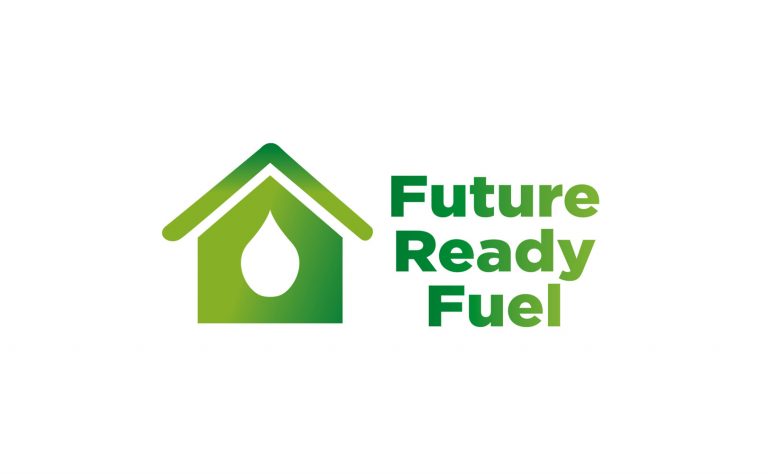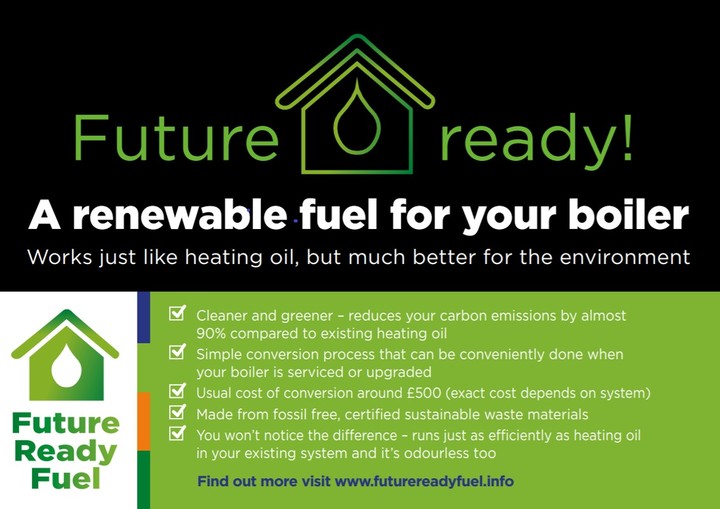
This is blog #1 in a 3-part series of “Can you be GREEN with Oil?” blogs from GASSING IT UP.
The content of these articles is accredited to the Future Ready Fuel campaign, which promotes Hydrotreated Vegetable Oil (HVO), a low-carbon liquid fuel made from waste fats and oils, as a viable, low-carbon alternative to kerosene for rural oil-heated homes.
The campaign, run by UKIFDA (the UK and Ireland Fuel Distributors Association) in conjunction with the trade association OFTEC (Oil Fired Technical Association), aims to provide information, conduct fuel trials, and demonstrate the technical feasibility and sustainability of HVO that offers a near 90% reduction in carbon emissions with minimal disruption to existing heating systems without requiring costly upgrades.
GASSING IT UP is very excited by the potential benefits of sustainable low-carbon renewable liquid fuels to off grid homeowners – not just to their homes and pockets but also to the environment – and wholeheartedly endorses the intent & objectives of the Future Ready Fuel campaign.
However, no more waffle, please explore & enjoy the content below and make your own mind up…
How off grid homes are different
There are around 1.7 million homes in the UK on heating oil and, except in Northern Ireland, most are located in rural areas. A further 686,000 mainly rural homes rely on oil heating in the Republic of Ireland.
Compared to properties on the gas grid, oil heated homes are much more diverse in character, age, design, and construction and collectively pose a unique and difficult decarbonisation challenge:
- 97% of oil heated homes in Great Britain have poor energy efficiency (EPC Band D – G) and often have low levels of insulation which makes them harder to heat and keep warm
- 46% were built pre-1919 with hard to insulate solid walls
- 51% are detached and typically larger than average so more expensive to insulate
- Many have period features or planning constraints which limits work which can be done
- Fuel poverty is higher and disposable income is lower in rural areas
- Their diversity and geographic isolation makes it difficult to put in place cost-effective roll-out programmes or achieve economies of scale
The challenge of decarbonising off grid homes

We fully support the government’s focus on transitioning homes onto low carbon heating to meet our net zero targets. This includes properties on oil heating.
However, we must recognise there are unique challenges to off grid homes which previous governments have often misunderstood or overlooked. To date, heat pumps have been prioritised as the main solution but it’s not that straight forward. Heat pumps can be an excellent choice for some homes, particularly those that are already energy efficient or when installed as part of a larger renovation project. However, households who already have efficient traditional heating will see little improvement to their quality of life to be motivated to invest in these expensive low carbon alternatives. For many others, making the switch is also impractical.
Forcing homes to switch would not only be very costly for the government and consumers as it would require significant subsidies, but we’re already seeing that consumers won’t want to make such a big financial outlay. This will slow down progress to achieving net zero.
Why heat pumps aren’t suitable for many off grid properties

Off grid homes are amongst the most difficult to convert to a heat pump as they often require significant insulation and other improvements, such as double-glazing, underfloor insulation, cavity wall insulation, and external wall cladding. These can be very costly and disruptive to install. Most people also only replace their boiler when it stops working but it can take over a month to install a complete heat pump system. This isn’t ideal if your boiler breaks down in winter.
It’s also not just homes. Many pubs, churches, village halls and schools rely on oil heating. The cost and disruption to switch these buildings from liquid fuels to heat pumps is far more expensive. Many also require ‘instant heat’ which can be turned on and off quickly, particularly village halls and churches, which you can achieve with boiler. Heat pumps work differently and take much longer to warm up a building.
10 challenges to converting oil heated properties to heat pump
- Installation costs: Total costs* can exceed £20,000
- Disruption: New radiators, piping and insulation are often required
- Period features: Renovations aren’t always compatible with period or character properties
- Hot Water Tank: You need to have an existing hot water tank or space for a new one
- Distress Purchase: Installation can take weeks, not ideal with a distress purchase
- Running Costs: Ignoring energy efficiency requirements leads to higher running costs
- Different timers: Boilers can be switched on for instant heat
- Grid Capacity: The electricity grid in rural areas needs upgrading to cope with demand
- Technician shortage: There’s a shortage of heat pump installers
- Less flexibility: With liquid fuels you can purchase when you want – no contracts
Heat Pump costs*
The government outlines the following costs to install a heat pump:
- Air Source – £8,000 to £10,500
- High Temperature Air Source – £6,300 to £13,000
- Ground Source – £35,000 to £45,000
Grants of up to £7,500 are available through the government’s Boiler Upgrade Scheme (BUS) to help subsidise some of these costs.
However, these figures do NOT include the cost of additional energy efficiency upgrades which may be required for the heat pump to work effectively:
- Improved loft insulation – £180 to £3,500
- Replacement windows and external doors – £1,200 to £10,000
- External wall insulation – £4,300 to £20,000
- Cavity wall insulation – £300 to £1,200
- Internal wall insulation – £2,500 to £11,600
- Floor insulation – £550 to £900
That’s why we believe oil heated homes should also have the choice of switching to a sustainable low-carbon renewable liquid fuel instead of a heat pump (the government prioritised main solution).
See the next blog in the series for more…
How can we help you?
If you would like to explore the feasibility of converting your current Kerosene-fuelled heating system to an HVO-fuelled heating system, please do not hesitate to contact us.
By choosing a trusted and registered local engineer, you’re not just protecting your home and keeping your heating system in top condition, you’re also supporting Whixley and the surrounding communities.

We highly recommend a visit the Future Ready Fuel website at www.futurereadyfuel.info/latest-news/ for the latest campaign news/progress.
Accreditation: The content in this article is accredited to the Future Ready Fuel campaign.
How can we help you?
If you would like to discuss any of the points raised in the article above please do not hesitate to contact us.
Remember, by choosing a trusted local engineer, you’re not just ‘Looking after your home, friends, and family’, you’re also supporting Whixley and surrounding communities.
Together, we can keep our friends and family safe, homes efficient, and our community strong.
Accreditation: This article is an output from Gas Safety Week 2025 and is reproduced courtesy of Gas Safe Register of which GASSING IT UP is a proud member.
